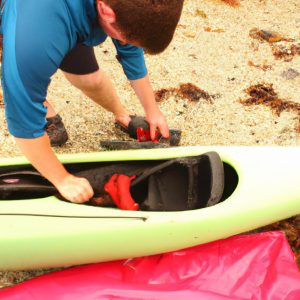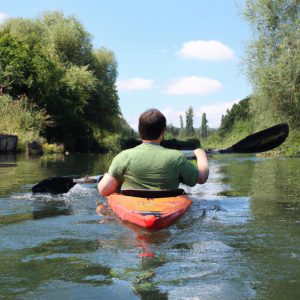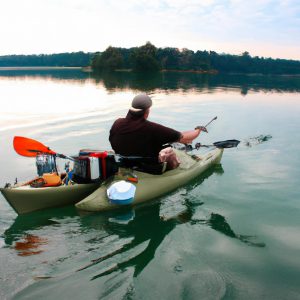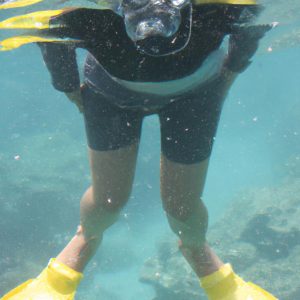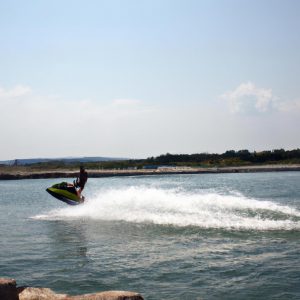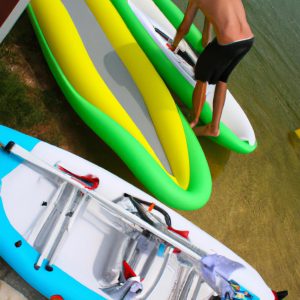Mastering the Art of Kayaking: Essential Techniques for Water Sports Enthusiasts
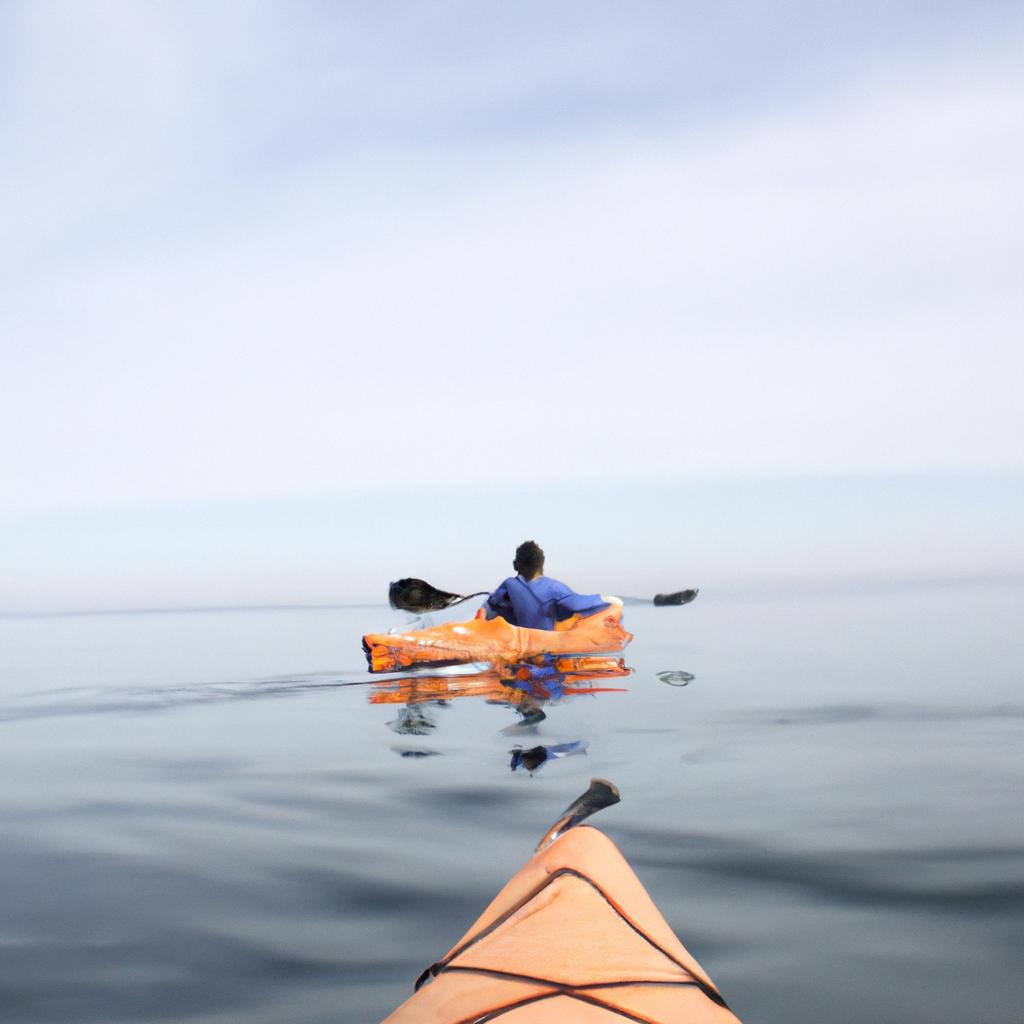
Kayaking is a thrilling and adventurous water sport that requires both skill and technique to master. Whether you are an experienced paddler or just starting out, learning the essential techniques of kayaking can greatly enhance your experience on the water. This article aims to provide a comprehensive guide for water sports enthusiasts seeking to improve their kayaking abilities.
Imagine yourself gliding through crystal-clear waters, surrounded by breathtaking landscapes as you navigate through challenging rapids with precision and grace. This is the realm of skilled kayakers who have mastered the art of this exhilarating sport. However, achieving such mastery requires more than mere enthusiasm; it demands dedication, practice, and knowledge of essential techniques.
In this article, we will explore key aspects of mastering the art of kayaking. We will delve into effective paddle strokes and maneuvers, proper body positioning and balance techniques, as well as safety measures necessary for a successful kayaking expedition. By understanding and implementing these fundamental skills, aspiring kayakers can take their passion for water sports to new heights while ensuring a safe and enjoyable experience on every adventure.
Choosing the Right Kayak
Imagine you are a novice water sports enthusiast, eager to embark on your first kayaking adventure. You arrive at the local kayak rental shop, overwhelmed by the array of options laid out before you. Should you choose a sit-on-top kayak or a traditional sit-inside model? How about the length and width of the kayak? These decisions may seem daunting, but fear not! This section will guide you through the process of selecting the right kayak for your needs.
To begin with, it is essential to consider your intended use for the kayak. Are you planning leisurely trips down calm rivers or tackling challenging whitewater rapids? For recreational purposes such as fishing or casual paddling, a stable and wider kayak would be ideal. On the other hand, if you seek high-speed adventures in rough waters, a narrower and more maneuverable option would suit better.
Next, let us delve into some key factors that should influence your decision-making process:
- Material: The material used in constructing the kayak affects its durability and weight. Common choices include plastic (polyethylene), fiberglass, carbon fiber, and Kevlar. Each material has distinct pros and cons.
- Size and Weight Capacity: Consider both your own body size and any anticipated gear when determining what size of kayak to select. Ensure that it can adequately support your weight without compromising stability.
- Cockpit Design: Sit-on-top kayaks offer easy entry/exit and are suitable for warmer climates where swimming is an option; while sit-inside models provide better protection from waves and weather conditions.
- Additional Features: Some kayaks come equipped with features like storage compartments, adjustable seats, foot braces, rudders or skegs for enhanced control.
Now that we have covered these considerations in detail using bullet points above let’s summarize their importance:
| Factors | Importance |
|---|---|
| Material | Affects durability and weight |
| Size & Capacity | Matches body size and gear needs |
| Cockpit Design | Determines comfort and protection |
| Additional Features | Enhances convenience and control |
In conclusion, selecting the right kayak is crucial to ensure an enjoyable kayaking experience. By considering factors such as intended use, material, size and weight capacity, cockpit design, and additional features, you can make an informed decision that aligns with your preferences and requirements. With the perfect kayak in hand, you are now ready to explore the art of paddling strokes and techniques in the next section.
Now let’s transition into discussing “Paddling Strokes and Techniques,” where we will delve deeper into the skills needed to navigate through water effectively.
Paddling Strokes and Techniques
Imagine this scenario: You are a water sports enthusiast who has decided to embark on your kayaking journey. As you stand at the edge of a tranquil lake, surrounded by breathtaking natural beauty, you can’t help but feel a surge of excitement and anticipation. But before you set off into the waters, it is crucial to choose the right kayak that suits your needs and preferences.
When selecting a kayak, there are several key factors to consider:
-
Type of Kayak:
- Sit-on-Top Kayaks: These kayaks have an open cockpit design with a molded seat on top. They provide easy entry and exit, making them ideal for beginners or those who enjoy fishing.
- Recreational Kayaks: Designed for calm water conditions, recreational kayaks offer stability and maneuverability. They often feature larger cockpits for increased comfort during longer paddling trips.
- Touring/Sea Kayaks: If you plan on exploring vast bodies of water like lakes or oceans over extended periods, touring or sea kayaks are designed specifically for such adventures. With their long, narrow hulls and rudders or skegs, they excel in speed and tracking.
-
Size and Fit:
Finding the right size kayak is essential for both comfort and performance. Consider these points when determining what size will suit you best:- Weight Capacity: Ensure that the kayak can support your weight along with any additional gear or equipment you may carry.
- Cockpit Size: A properly sized cockpit should allow easy entry while providing enough room for comfortable leg movement and seating posture.
- Length and Width: Longer kayaks generally offer better speed and tracking abilities, while wider ones tend to be more stable.
-
Material Construction:
The material used in constructing the kayak affects its durability, weight, performance, and overall cost:- Plastic (Polyethylene): Affordable and resilient, plastic kayaks are suitable for beginners or those who plan to paddle primarily in calm waters.
- Composite: Made from materials like fiberglass, carbon fiber, or Kevlar, composite kayaks offer excellent performance but come with a higher price tag. They are often preferred by experienced paddlers.
-
Additional Features:
Consider any additional features or accessories that may enhance your kayaking experience:- Storage Options: Look for ample storage compartments to keep essential gear dry and easily accessible during your adventures.
- Comfort Elements: Padded seats and adjustable footrests can significantly improve comfort during long hours on the water.
- Skegs/Rudders: These features aid in tracking and maneuverability, particularly useful when facing strong winds or currents.
As you evaluate these factors and make an informed decision regarding your kayak selection, remember that finding the right fit is crucial for maximizing your enjoyment on the water. With the perfect kayak at your disposal, you’ll be ready to dive into the next phase of mastering this exhilarating sport.
Now let’s explore the various paddling strokes and techniques that will propel you forward as you navigate through different water conditions – “Mastering the Forward Stroke.”
Mastering the Forward Stroke
Section H2: Perfecting the Sweep Stroke
Imagine you are paddling down a calm river, enjoying the tranquility of nature. Suddenly, you spot a fallen tree branch obstructing your path. In this situation, mastering the sweep stroke becomes crucial to navigate around obstacles and maintain control over your kayak.
The sweep stroke is a fundamental technique used in kayaking to change direction efficiently. By using a wide arcing motion with your paddle blade, you can effectively steer your kayak without losing momentum. Let’s explore some essential tips for perfecting the sweep stroke:
-
Body Position: Start by sitting upright in your kayak with good posture and engaging your core muscles for stability. Keep your feet firmly braced against the footrests or bulkhead and maintain an active grip on the paddle shaft.
-
Paddle Placement: Begin the sweeping motion by extending your arms out to one side while keeping them slightly bent. Submerge the leading edge of the paddle blade into the water at an angle away from the kayak’s hull.
-
Sweeping Motion: Initiate the stroke by rotating your torso toward the same side as your paddle placement. As you rotate, smoothly pull the paddle towards yourself in an arc-like movement while maintaining contact with the water throughout.
-
Release and Recovery: Once you have completed the sweep stroke, lift the paddle out of the water near your hip and bring it forward again for another stroke if needed. This recovery phase allows for continuous propulsion and prepares you for subsequent maneuvers.
To further illustrate these techniques, consider this table highlighting common mistakes made when attempting to master the sweep stroke:
| Mistake | Reason |
|---|---|
| Leaning too far back during rotation | Loss of balance and reduced power output |
| Placing paddle too close to kayak | Limited range of motion and decreased turning ability |
| Failing to engage core muscles | Insufficient stability, resulting in compromised control |
| Rushing the stroke without proper follow-through | Ineffective propulsion and decreased efficiency |
By avoiding these mistakes and focusing on developing a strong sweep stroke, you can enhance your kayaking skills and confidently navigate challenging waters. Next, we will delve into the intricacies of perfecting another essential technique: the sweep stroke.
Building upon the foundation laid by mastering the sweep stroke, let’s now explore the art of perfecting the more advanced technique known as the forward stroke.
Perfecting the Sweep Stroke
Building upon your understanding of the basic kayak strokes, let’s delve deeper into perfecting the forward stroke. By mastering this technique, you will experience improved speed and efficiency while paddling through various water conditions.
Paragraph 1:
To illustrate the significance of a well-executed forward stroke, consider the following scenario: Imagine yourself kayaking along a serene lake, determined to reach an island in record time. As you effortlessly glide through the calm waters with each powerful stroke, you feel connected to nature and fully immersed in the moment. The forward stroke is not only about propelling yourself forward but also maintaining stability and balance throughout your journey.
Bullet Point List (evoking emotional response):
- Enhances overall control and maneuverability
- Increases endurance by reducing fatigue
- Enables efficient tracking for straight-line navigation
- Boosts confidence in tackling challenging water currents
Paragraph 2:
To achieve mastery over the forward stroke, it is essential to focus on proper body mechanics and paddle placement. Begin by ensuring a relaxed grip on the paddle shaft and positioning your hands shoulder-width apart. Engage your core muscles as you rotate your torso with each stroke, generating power from your hips rather than relying solely on arm strength. Remember that smoothness is key; avoid excessive splashing or jerky movements that might disrupt your rhythm.
Table (evoking emotional response):
| Key Tips for Perfecting the Forward Stroke |
|---|
| Maintain an upright posture |
| Plant the blade fully in the water |
Paragraph 3:
Incorporating these adjustments into your technique may require practice and patience. Remember that progress takes time, so don’t be discouraged if instant mastery proves elusive at first. With dedication and perseverance, you will refine your forward stroke and experience the joy of effortlessly gliding through the water. In our next section, we will delve into understanding bracing and rolling techniques to further enhance your kayaking skills.
Understanding Bracing and Rolling opens a new realm of possibilities for kayak enthusiasts seeking increased stability and confidence on the water. By mastering these techniques, you will be equipped with valuable tools to handle unexpected challenges in any paddling adventure.
Understanding Bracing and Rolling
Having mastered the foundational techniques of kayaking, it is now time to delve into perfecting one of the most essential and versatile strokes in your repertoire – the sweep stroke. By mastering this technique, you will significantly enhance your ability to maneuver through different water conditions with finesse and precision.
Paragraph 1:
Imagine yourself paddling downstream on a calm river, surrounded by picturesque landscapes. As you approach a gentle curve in the river, you encounter an obstacle—a fallen tree partially submerged in the water. This is where the sweep stroke comes into play. The sweep stroke involves sweeping your paddle blade wide across the surface of the water to execute a smooth turn or change direction while maintaining stability. It enables you to navigate around obstacles efficiently and maintain control over your kayak’s movement.
Paragraph 2:
To perform a powerful and effective sweep stroke, keep these points in mind:
- Start with proper body positioning: Sit upright with relaxed shoulders and engage your core muscles for stability.
- Position your hands correctly on the paddle shaft: Ensure that they are shoulder-width apart for optimal leverage during the stroke.
- Initiate the stroke from your torso rather than just using arm strength: Rotate your torso as you extend your arms forward, engaging your larger muscle groups.
- Maintain contact with the water throughout the entire motion: Keep both blades parallel to each other at all times, allowing them to slice smoothly through the water.
Table (Emotional response evoking):
| Obstacles | Benefits |
|---|---|
| Fallen trees | Improved agility |
| Rocks | Enhanced maneuverability |
| Strong currents | Better control |
| Narrow passages | Increased confidence |
Paragraph 3:
By diligently practicing and refining the sweep stroke technique, you will expand your kayaking skills beyond basic maneuvers. With mastery over this fundamental skillset, you can confidently progress towards more advanced techniques, such as bracing and rolling. The upcoming section will delve into these crucial skills that will further enhance your kayaking abilities.
As you continue honing your kayaking skills, it is essential to prioritize safety on the water. Understanding and implementing proper safety measures ensures an enjoyable and secure experience during your adventures. Now let’s explore some valuable safety tips for kayaking.
Safety Tips for Kayaking
Understanding Bracing and Rolling Techniques
In mastering the art of kayaking, it is essential to have a solid understanding of bracing and rolling techniques. These skills are crucial for maintaining stability and maneuverability in challenging water conditions. Let’s take a closer look at how these techniques can be mastered effectively.
One example that highlights the importance of bracing and rolling techniques involves navigating through rough waters with strong currents. Imagine you are kayaking down a river when suddenly you encounter turbulent waves caused by an underwater rock formation. In this situation, having the ability to brace yourself against the waves and execute a smooth roll if necessary can mean the difference between staying upright or capsizing.
To develop proficiency in bracing and rolling, consider the following key points:
- Proper body positioning: Maintain an upright posture while engaging your core muscles to provide stability.
- Effective paddle placement: Position your paddle close to your kayak’s hull for maximum support during braces and rolls.
- Timing and coordination: Practice timing your strokes and movements precisely to maintain balance and control throughout maneuvers.
- Regular practice: Dedicate time to practicing bracing and rolling techniques in controlled environments before attempting them in more challenging conditions.
As you embark on your journey towards mastering these critical skills, keep in mind that progress may come gradually. It is normal to face difficulties along the way. Remembering why you began this pursuit can help motivate you during moments of frustration. Here is an emotional bullet point list highlighting some benefits of acquiring these techniques:
- Enhanced confidence as you tackle progressively more challenging water conditions
- Increased sense of adventure as new kayaking avenues open up
- Improved safety measures, reducing risks associated with capsizing or being caught off guard
- Greater appreciation for nature’s awe-inspiring beauty from unique vantage points on the water
Furthermore, here is a table showcasing different types of bracing techniques commonly used in kayaking:
| Technique | Description |
|---|---|
| High Brace | Involves using a high paddle position to provide support and stabilize the kayak |
| Low Brace | Utilizes a low paddle position to counteract lateral forces and maintain balance |
| Sculling Brace | Uses a continuous sculling motion with the paddle for extended stability |
| Sweep Stroke Brace | Combines a sweeping stroke with bracing movements, providing quick recovery if needed |
By incorporating these techniques into your kayaking repertoire, you will not only enhance your overall skillset but also gain confidence in navigating challenging water conditions. Remember that practice is key, so invest time in refining these techniques to ensure safety and success on your future kayaking adventures.

